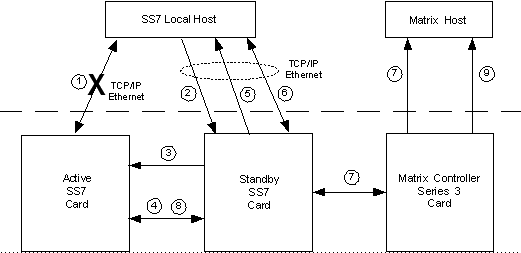
You are here: CSP Developer’s Guide: Common Channel Signaling > 2 Introduction to SS7 > SS7 Local Host Initiated Redundancy Switchover
SS7 Local Host Initiated Redundancy Switchover

Purpose
The SS7 Local Host Initiated Redundancy Switchover feature allows a host directly connected to the SS7 active and standby cards, by a
TCP/IP Ethernet connection, to initiate a SS7 redundancy switchover.
Description
This feature is an enhancement to the existing SS7 Card Direct Host Ethernet Connection feature. Initiating a SS7 card switchover requires that the SS7 local host is connected to both SS7 cards via a direct TCP/IP Ethernet connection.
When the SS7 local host detects an active SS7 card failure, it initiates a SS7 switchover by sending a Become Active (0x00A1) API message to the standby SS7 card via the direct Ethernet connection. This causes the active SS7 card to reset (eventually becomes standby) and the standby SS7 card to become active. The host then communicates with the newly active card (previously the standby card) for traffic messages.
The SS7 Local Host Initiated Redundancy Switchover feature is also consistent with the CSP 2000 Matrix Card host interface and switchover scheme.
The SS7 local host is aware of each of the SS7 cards active/standby status based on the Poll (0x00AB) API message sent from each of the redundant SS7 cards. The switchover sequence and related figure below describe and illustrate the process of detecting the failure of the active SS7 card through the switchover of the standby SS7 card to active status. Note that the circled numbers on the figure correspond to the steps below.
1. When the redundant SS7 cards (active and standby) process messages to and from the SS7 local host, the host may determine that the connection to the active SS7 card failed.
2. The SS7 local host then sends a Become Active (0x00A1) API message to standby SS7 card.
3. When the standby SS7 card receives a Become Active API message, it sends an internal RESET_CONFIGURATION message to the active SS7 card. The active SS7 card resets upon receiving the RESET_CONFIGURATION message from the standby SS7 card.
4. The standby SS7 card status becomes active immediately, since it is already in synchronization with the previously active SS7 card.
5. The newly active SS7 card then sends a Poll API message to the SS7 local host indicating that it is now active.
6. The SS7 local host resumes traffic by processing messages to and from the standby SS7 card.
7. The CSP Matrix Series 3 Card detects a SS7 card status change; it sends a CCS Redundancy Report API message to the Matrix host to report this status change.
8. During this time the active SS7 card is synchronizing with the standby SS7 card. After synchronization the previously active SS7 card becomes standby.
9. The Matrix host is informed of the card status change by the CCS Redundancy Report and Card Status Report API messages after the switchover is complete.
Important! If an active or single SS7 card receives a Become Active API message from the SS7 local host, it sends a positive acknowledgement to the local host and no further action is taken.
Important! If a SS7 card, in the synchronization state, (a state other than active, standby, or single) receives a Become Active API message from the SS7 local host, a negative acknowledgement with status 0x14 (Invalid Command) is sent to the local host. No further action is taken.
Figure 2-11 SS7 Redundancy Cards Switchover Sequence
